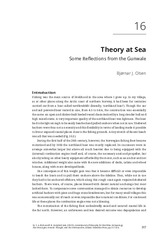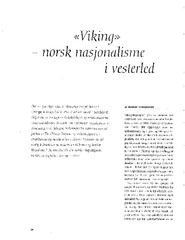Artikler, rapporter og annet (arkeologi, historie, religionsvitenskap og teologi): Nye registreringer
Viser treff 41-60 av 301
-
Theory at Sea: Some Reflections from the Gunwale
(Chapter; Bokkapittel, 2023)Fishing was the main source of livelihood in the area where I grew up. In my village, as at other places along the Arctic coast of northern Norway, it had been for centuries carried out from a boat called nordlandsbåt (literally, ‘northland boat’). Though the oar and sail powered boat varied in size, from 4.5 to 14 m, the construction was essentially the same: an open and clinker-built keeled vessel ... -
Reformasjonen på Færøyene - en nordtysk kulturarv?
(Chapter; Bokkapittel, 2023-12-18)The chapter examines the proposition, first advanced by Faroese historian Louis Zachariasen, that the Reformation was introduced to the Faroe Islands by German merchants from Hamburg who held trading privileges and governing authority in the Faroes between ca. 1520 and 1553. Hamburg and the Faroes represented two dramatically different cultural spaces. In addition to obvious differences in language ... -
In the northern periphery of Russia abroad. The Norwegian destiny of Anatol Ye. Heintz (1898–1975), palaeontologist and native of St Petersburg
(Journal article; Tidsskriftartikkel; Peer reviewed, 2023-02-13)This article provides an exposé of the life and work of Anatoliy Yevgenyevich Geynts, in Norway known as Anatol Heintz. Heintz was born and raised in St Petersburg, became a Russian refugee after the revolutionary events in Russia in 1917–1918, and ended up in Norway with his family. Later Heintz became renowned in the world of science as a Professor, Academician, and one of the founding fathers ... -
The Development of Microhistorical Databases in Norway A Historiography
(Journal article; Tidsskriftartikkel; Peer reviewed, 2023-05-11)Norwegian work on microdata started out with the full count 1801 census and census and vital records from around the capital. Today, most census and ministerial records from 1801 until the mid-20th century have been scanned, transcriptions are being completed, much is encoded and made available via the websites of the Digital National Archives and UiT The Arctic University of Norway. This article ... -
Alderdommens fenomenologi: Om kropp, tid og passivitet
(Journal article; Tidsskriftartikkel; Peer reviewed, 2023-10-13)Simone de Beauvoir og Jean Améry har skrevet avgjørende verk innen aldringens fenomenologi som avdekker sentrale sider ved den aldrendes erfaring av kropp og tid. Begge mener at det innskrenkede handlingsrommet og den forkortede fremtidshorisonten som alderdommen medfører, truer livets meningsfullhet. Dette hviler imidlertid på premisset om at det meningsfulle livet utfolder seg som ungdommelighet, ... -
What was Killing Babies in Trondheim? An Investigation of Infant Mortality Using Individual Level Cause of Death Data, 1830–1907
(Journal article; Tidsskriftartikkel; Peer reviewed, 2023-03-02)This paper examines infant mortality amongst newborns in Trondheim city, 1830–1907, working specifically with individual level cause of death data. Findings show that infant mortality in the city started to drop from 1895, primarily as a result of a decline in post-neonatal mortality. At the start of the decline air-borne diseases accounted for nearly half of the deaths, and water-food borne for ... -
"Viking" - norsk nasjonalisme i vesterled
(Journal article; Tidsskriftartikkel, 2002)Den 12. juli 1893 seilte et vikingskip inn på havna i Chicago, et knapt halvår etter at det var sjøsatt i Sandefjord. Skipet var en tro kopi av Gokstadskipet, og anledningen var verdensutstillingen til minne om Colombus` "oppdagelse" av Amerika 400 år tidligere. Ankomsten ble slått stort opp på forsida av The Chicago Tribune, og seilasen figurerte i amerikanske og norske aviser i ukesvis. Hvordan ... -
Lapplands Helvete. Klassekamp under Nordlysflammer
(Chronicle; Kronikk, 2023)Det er femti år siden boka med denne tittelen kom ut, utgitt på det ærverdige Pax Forlag i 1973. Ikke minst i forbindelse med Nils Gaups storfilm «Sulis 1907» med kinopremiere i begynnelsen av oktober, har denne bokutgivelsen krav på ny aktualitet og nylesning. «Klassekamp under nordlysflammmer» med undertittelen «Nord-norske arbeidere i kamp 1889 – 1918. En dokumentarisk beretning» var skrevet av ... -
Vardøhus festnings betydning i Christian IVs ekspansive nordområdepolitikk 1596-1648
(Conference object; Konferansebidrag, 2022)Perioden 1596-1648 markerer regjeringstiden for kong Christian IV. I første del av hans tid på den dansknorske tronen er det konfliktene i nordområdene som står i fokus for kongens innenriks- og utenrikspolitikk. Ett periodeskille innen denne første halvdel av kongens tid på tronen er 1613 som markerer utgangen på Kalmarkrigen. Fredsslutningene fikk stor betydning for Nord-Norge og for viktigheten ... -
The Witches of Finnmark. Tekststykker til forestilling. Framført i Bølgen Kulturhus, Larvik 25/11, Arendal Kulturhus 26/11 og Victoria Nasjonale Jazzscene i Oslo 27/11
(Conference object; Konferansebidrag, 2022)Anders Buaas / Rune Blix Hagen - THE WITCHES OF FINNMARK A musical journey through time Gitarist og komponist Anders Buaas skrev og ga ut sin instrumentale trilogi «The Witches of Finnmark» i perioden 2015-2019. Den har høstet strålende kritikker fra inn- og utland. Musikken beskriver historier og stemninger fra hekseprosessene i Finnmark utover 1600-tallet. Inspirasjonen til denne musikken ... -
Highland Asia as a World Region: An Introduction
(Chapter; Bokkapittel, 2023)Imagine, for a moment, that there are no borders, geopolitical tensions, political conflicts, or stringent visa regimes; a world where trails and paths fork out uninterrupted by states haunted by manifest anxieties over territory, sovereignty, and the reverberations of political cartography. In such a world, it would be possible for you, provided you possess extraordinary stamina, determination, and ... -
Downscaling Cosmological Landscapes: from Early to Mid-Holocene Rock Art in Northern Norway
(Chapter; Bokkapittel, 2021)The rock art of northern Norway is well-known, not least due to the UNESCO World Heritage sites at Alta dating back to c. 5200 cal BC. It is perhaps less well-known that northern Norway also has earlier rock art dating back to c. 9000 cal BC. While the early phase of rock art is dominated by large, natural sized animals such as elk, reindeer, bear and whale in a naturalistic style, the later period ... -
On the View of 'the Other' - Abroad and At Home: The Geography and Peoples of the Far North, According to Historia Norwegie
(Chapter; Bokkapittel, 2020)In this discussion I want to focus the spotlight on what Historia Norwegiae (hereafter H.N.) reports on relations in the Far North, on the Sámi and on the interaction between Norwegians and Sámi, as well as additional peoples further to the east in the North Calotte.2 I shall concentrate on a summary of the peoples who were perceived, to a greater or lesser extent, as standing outside the Norse, ... -
The Trading Networks of the High North during the Sixteenth Century
(Chapter; Bokkapittel, 2020)The aim of this article is to sketch the main features of the trading networks that dominated northern Fennoscandia and part of northwestern Russia during the period when the Reformation was introduced in the North, and the following century. By drawing a broad picture of the various actors that were engaged in these interactions in the borderless region in the North, I hope to highlight some of the ... -
The Russian Revolution of 1917 and the Kremlin's Policy of Remembrance
(Chapter; Bokkapittel, 2020)The first time I visited the Lenin Mausoleum was on an autumn day in 1971. Leaves blew over Red Square, and down in the sarcophagus Lenin was lying in dim illumination, immaculately dressed in a dark suit, white shirt and a red necktie. Despite his attire he made a dismal impression with his yellow, parchment-like skin. 20 years later Soviet society dissolved, without Lenin being offered a decent ... -
Soviet Prisoners of War in Norway and Finland –treatment, mortality and forgotten memories
(Chapter; Bokkapittel, 2020)The article describes German and Finnish treatment of Soviet prisoners of war in Norway and Finland, the death rates among Soviet prisoners of war in the two countries and why these prisoners can be described as a forgotten part of the national collective memory in Norway and Finland. -
The war in the North - everyday life, Soviet prisoners of war and Norwegians´ memories
(Chapter; Bokkapittel, 2020)The paper dwells upon everyday life, Soviet prisoners of war and Norwegians' memories during the Second World War in northern Norway. Characteristics of the ideological war against the Soviet Union, mistreatment of Soviet prisoners of war, civilian forced labour in northern Norway, Norwegians memories and contact with the Soviet prisoners, the politics of memory and repatriation are demonstrated. ... -
Sámi Myths and Medieval Heritage
(Chapter; Bokkapittel, 2020)Sámi landscapes are pluralistic and contain traces of a variety of activities occurring in the past and present. This includes remains of medieval houses and hunting installations that are different from the ones used in later Sámi contexts. The Sámi have created their own interpretations of these enigmatic features in the landscape, relating, for instance, so-called ‘Stállo’ house grounds, reindeer ... -
Introduction: Currents of Saami pasts
(Chapter; Bokkapittel, 2020)A scientific field is a constant process, and, as all processes, it is defined by dialectics, since standpoints are only defined in opposition to something else. Saami archaeology is no exception, and this field emerged precisely because of oppositions, when political conflicts enforced the realization of a lack of consideration of the Saami presence in the prevailing understanding of the past in ... -
Sticky structures and opportunistic builders - The construction and social role of longhouses in northern Norway
(Chapter; Bokkapittel, 2020)The longhouse has been a turning point for research on prehistoric farming societies in Scandinavia for several decades. Yet, no comprehensive study has been made of this house type and its context, variations and social implications in the Far North. In this chapter, we present the currently available longhouse material within the three northernmost counties of Norway. The 50 longhouses that have ...


 English
English norsk
norsk


















